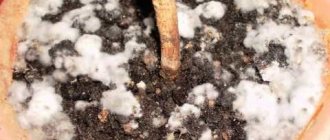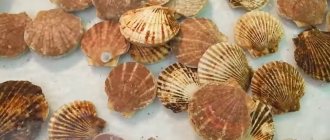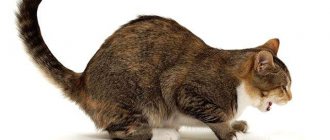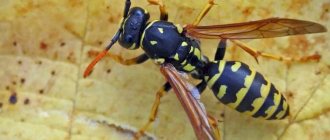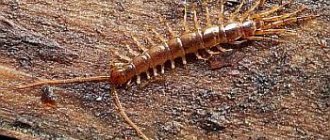What not to treat
| A drug | Indications. Treatment regimen | Notes |
| Drops Lawyer | From endo- and exoparasites, including worms and different types of ticks. Dose - 0.1 ml/1 kg. Take the required amount from the tube with a syringe, remove the needle and drop it onto the skin. Hold the animal in your arms for 10-15 minutes to prevent it from scratching the area where the medicine was applied. Repeat after 14 days | Do not drip onto scratched areas of the skin. |
| Drops of Stronghold | If this is a 6% solution, then calculate the dosage, taking into account that it is 0.1 ml for 1 kg. If 12%, then 0.05 ml | |
| Otodectin injections | 0.2 ml/1 kg. The injection is made in the withers area under the skin. Repeat the procedure after 10 days | If the animal is severely affected, a 4-fold injection is possible |
The results of treatment appear gradually. Full recovery occurs after 3-4 weeks, when all adult ticks and laid larvae are destroyed or immunity is restored so much that the eggs have no opportunity to develop.
Important! Only one drug can be used. The combination threatens intoxication
A repeated cycle of digging and injections is needed in order to destroy those mites that hatched from the deposited larvae. 14 days is their ripening period. The drugs do not affect the larvae because they are protected by the shell.
Choose a remedy for lice for your guinea pig based on reviews or a recommendation from a veterinarian. The following drugs should not be used:
- Ethnomazan;
- Stomazan;
- Butox.
They are well advertised but are used exclusively for the cage and its contents. They can easily harm the animal and even lead to death.
Use only proven methods for treating your guinea pig. Keep it clean and try to prevent the appearance of lice or other parasites.
Worms
Due to the fact that the main property of this group of parasites is to absorb nutrients from the animal’s blood, this can lead to exhaustion. Typically, guinea pigs are inhabited by tape and round parasites. Worm larvae of this type are dangerous not only for the animal, but also for the owner. With severe infection, you can see not only worm larvae in the stool, but also quite adult individuals with the naked eye. The animal is characterized by lethargic behavior, drowsiness and decreased appetite. If the infection is very strong, parasites crawling out of the anus can also be seen with the naked eye.
If the infection is not severe, you can give the animal a suspension of prazicide for kittens. The amount is calculated at the rate of 1 gram per 1 kg of animal weight. Dirofen paste has a good reputation among veterinarians. When treating an animal with medications, you need to treat the cage and accessories with a chlorine-containing solution.
Methods of treatment and prevention of diseases
Today, means of treatment and protection against lice eaters are presented in a wide range. For ease of use, they are available in several forms:
- spray;
- drops;
- emulsion;
- shampoo;
- powder;
- collar.
Sprays are prepared based on biocidal elements. The simplest method of application is to spray the skin of the pig and spread it over the hair using massaging movements. At the initial stage of the disease, one application is sufficient. The drugs Blokhnet, Dana, Bars, and Inspector have proven themselves well.
The drops have the same base as sprays and are designed to get rid of ticks and lice. It is enough to apply a few drops on the spine in the area of the animal’s withers, where it cannot reach. Today, the effectiveness of this form is recognized as the simplest and most effective, because it provides a long-term preventive effect.
Emulsions are diluted with water or injection solution, since they are produced in concentrated form. The solution is used to treat wool. Recommended: Stop Itching, Atop 7+.
Shampoo is the safest way. A properly selected shampoo can prevent the appearance of lice by creating a protective barrier on the animal's fur. A sick animal cannot be cured by washing it with shampoo the first time. Use Phytoelite, Dana, Frontline and Bars. Their action, consistency and consumption are identical.
Collars quickly get rid of lice and protect your pet for a long time. The disadvantage of this form is a possible allergy of the pig to the components, which will be expressed in the form of skin irritation.
The powder is very fine and has a powder-like consistency. Advantages: relief from itching and irritation of the skin in a short period of time. It is enough to rub it into the skin once to maintain the effect for 1.5 weeks.
After treating the animal, you need to treat its cage or enclosure, as well as all the objects it uses. This is done with a solution of special preparations.
How to withdraw
To treat parasitic infections external preparations are used ; they are sold in a veterinary pharmacy. When purchasing, pay attention to the label; it should indicate that the product is intended specifically for rodents. Drops and sprays for cats contain a higher concentration of the insecticidal substance and can cause poisoning in guinea pigs.
For treatment the following are used:
- Shampoos;
- Sprays;
- Powders;
- Drops.
Are there allergies to guinea pigs?
Preparations containing pyrethrin are considered the least harmful. These include:
- Spray 8 in 1;
- Flea&Tick;
- Spray Beaphar.
Products based on synthetic pyrethrin analogues are more potent. This:
- Frontline;
- Spray "Bars" for rodents;
- Bolfo.
It is better to treat the rodent outdoors or near an open window, since many preparations have an unpleasant chemical odor.
What exactly should I do? The rules for using insecticides are as follows:
- The medicine should not get on the pet’s face or eyes;
- The skin is treated with a jet of liquid against the growth of the fur;
- After the procedure, the animal should be held in your arms until the hair is completely dry.;
- At the same time, the wool of all animals living in the house is processed;
- In some cases, disinfection should be repeated after a week to destroy insects hatched from eggs.
Veterinary clinics use injections of the drug Ivermectin. However, the active substance is quite toxic, so it is used only in extreme cases.
Redness of the skin, itching, hair loss may indicate other diseases: allergic dermatosis, neurodermatitis, streptococcal infection, metabolic disorders. Be sure to show your pet to the veterinarian so as not to miss a dangerous pathology.
Types of lice
Oddly enough, the varieties of lice in pigs are quite numerous. In practice, in almost 99% of cases, only two types are found, and another one is diagnosed much less frequently:
- Typically, “pigs” are parasitized by two types of lice: Gliricola porcelli and Gyropus ovalis.
- In extremely rare cases, parasites of the species Trimenopon hispidium can be found on the body of an animal.
The most characteristic species is that of G. Porcelli. Their body color is closer to yellowish, and therefore they are quite easy to spot. These parasites are quite long and when moving they noticeably “squirm”. As a rule, they are found in the form of clusters in the eye sockets and around the hair roots.
G. Ovalis are more compact in shape (as their name suggests), but in all other respects they are very similar to the previous variety.
Trimenopon hispidium, then this type of lice is extremely small and most often they are simply not noticed. However, in cases of severe infestations, you can see large accumulations of these parasites, vaguely reminiscent of tiny spiders.
Why do guinea pigs shed?
Shedding is a natural process during which new fur grows in place of the lost fur. Coat change can be seasonal or juvenile (age-related). If the animal is kept in good conditions and eats properly, then molting usually takes place without any negative consequences.
But it happens that this process is not associated with natural causes. It can be caused by poor diet and lack of vitamins in food, improper living conditions, stress, pet illness or parasites.
Attention! If your pet's fur is actively falling out throughout the year, bald patches appear, the skin turns red and peels, pay attention to these symptoms. The animal needs treatment or changes in living conditions
Ways and symptoms of infection
Peak activity of lice eaters occurs in winter. During this period, the guinea pig grows thick hair and the parasites have a lot of places to hide. To avoid infection, clean and disinfect the cage regularly. Animals become infected mainly on the street and through contact with other animals. A person can also carry larvae on clothing, but this is rare and mostly affects fleas. The source of infection can be purchases at a pet store, especially if it is hay or bedding. Some individuals for sale may be infected and transfer parasites to store goods.
Symptoms of lice in guinea pigs:
- The main symptom of the presence of parasites in the fur is itching. The animal constantly itches, bites itself, tries to destroy parasites, which often injures itself and leaves small abrasions all over its body.
- Behavior changes completely. The pet is restless, sleeps little, and loses its appetite. As a result, immunity and body weight decrease.
- The appearance becomes sloppy, since almost all the time is devoted to fighting the irritant.
- If you part the fur and look closely, you can see small gray moving spots. These are the lice eaters.
In addition to great discomfort, they carry a variety of diseases, bacteria, viruses and parasites. With a weakened and weakened immune system, the chance of getting sick increases every day. They pose no danger to humans.
Routes of infection
Fleas are known to be jumping creatures that move from one animal to another. Most often, infection with ectoparasites occurs from other pets with whom the guinea pig comes into contact. A rodent has every chance of encountering arthropods on the street, especially while walking on the grass.
In most cases, cat fleas are found on domestic rodents. This type of ectoparasite is adapted to exist both in private households and in apartments. Despite the name of the insect, the cat flea lives not only on cats, but also in the fur of dogs, domestic hedgehogs, rats and other rodents.
What is it and what does it look like?
Ringworm is a dermatological viral disease caused by the active growth of fungal cells. A disease occurs on the skin. The first symptom is:
- hair loss;
- peeling;
- redness;
- itching
If you do not help your guinea pig in time, the lichen will quickly spread throughout the rodent's entire body. In addition, other animals living in the same cage with the patient, as well as the animal’s owners, are at risk of infection.
A loving owner always worries when a pet is unwell. When faced with a similar problem for the first time, the question will invariably arise of how to deal with the virus.
Guinea pigs are susceptible to two types of lichen:
- Trichophytosis;
- Microsporia.
Spores of both fungi can be stored for quite a long time on the skin of animals, in the soil, on objects before becoming active.
It is not at all necessary that the carrier animal will suffer from any type of lichen. Most often, the disease progresses on the body of animals that are kept in unsanitary conditions or have weak immunity.
What symptoms indicate the presence of fleas
Signs that an animal is being bitten by fleas are as follows:
- redness and peeling of the skin, bite marks (usually on the stomach) in the form of red dots;
- the pig behaves restlessly, shakes its head, itches, eats poorly, becomes less active;
- In places where insects accumulate, hair loss may occur.
Insects pierce the skin and drink blood. The bites are painful, and there are no anesthetics in the saliva. In the affected areas, the skin becomes inflamed, itches, and hurts when scratched.
Flea bites cause red spots on your pig's skin.
Infections
Guinea pigs can become infected with fungal, viral, and bacterial infections, such as:
- Plague is a dangerous disease of viral etiology. It is highly contagious and often ends in the death of the rodent. Once initiated, the latency period in most animals is typically a maximum of 21 days. After which symptoms of the disease are observed. The animal becomes lethargic, indifferent to what is happening. He may experience seizures, problems with coordination, and paralysis of his hind legs. Unfortunately, there is no cure for this disease and, if the diagnosis is confirmed, the infected scree is euthanized.
- Pseudotuberculosis is an infectious disease of a bacterial nature that is often diagnosed in guinea pigs. Infection is possible through contaminated food.
The infection often results in the death of the pet, as it occurs in a lightning-fast form
Therefore, it is important to know the symptoms of the disease in order to begin treatment in a timely manner. The main symptom of infection is stomach upset. Mucus and blood can be found in the stool. In addition, the owner may notice loss of appetite in the animal, inflammation of the conjunctiva, enlargement of the mesenteric lymph nodes, and convulsions.
What to do when it appears? It is necessary to show the rodent to a veterinarian as soon as possible. If the diagnosis is confirmed, then antibiotics and sulfonamides are prescribed. Tetracycline can be prescribed for treatment in loading dosage.
Paratyphoid fever is an intestinal infection caused by bacteria and accompanied by signs of gastrointestinal damage, such as persistent diarrhea and bloating. The pig's stool is greenish and has an unpleasant odor. The animal refuses to eat, moves little, and is disheveled. If infection is confirmed, tetracycline and sulfadimizine are prescribed, and anti-typhoid serum is administered. In addition, to reduce the likelihood of re-infection, you should clean up after the rodent more often. Your pet's diet should consist of foods that are quickly digestible. The animal must have constant access to water. Pasteurellosis is a bacterial zoonotic disease that is dangerous to humans. If a guinea pig is sick, it will experience symptoms of respiratory damage: purulent nasal discharge, sneezing, shortness of breath, wheezing. As the infection progresses, indigestion, pustules, redness of the skin, and convulsions occur. The disease often causes the death of a rodent. Young individuals die especially often. If the infection is severe, the animal is destroyed. Treat a sick rodent with antibiotics. When pets have multiple antibiotics, antibiotic therapy is prescribed for all pets, regardless of whether they have symptoms of infection or not. Medicines are given within 7 days from the moment the disease is detected
It is also important to disinfect the room where the rodent is kept. Lymphocytic choriomeningitis is a dangerous viral disease not only for the animal, but also for its owners, which usually ends in the death of the pet. An infected individual exhibits elevated temperature and asthenia. The disease is incurable, so the infected individual is destroyed. Bordetellosis is a disease that affects not only guinea pigs, but also cats, dogs and other rodents. The main measure to prevent infection is vaccination of cats and dogs.
There is also a vaccination against bordetellosis for guinea pigs, but, unfortunately, it is ineffective and only alleviates the course of the disease.
An infected pig may sneeze and have difficulty breathing. She may have a fever, nasal discharge, conjunctivitis, ear inflammation, loss of appetite, and impotence. Often, with such an infection, the pet's head is turned to the side. When a disease is detected, the pet must be treated comprehensively; the animal is prescribed antibiotics and sulfonamides.
Prescribe either Baytril (s.c.) at a dose of 5 mg per kg of body weight for 5 days or gentamicin (i.m.) at a dose of 4-5 mg per kg of body weight. In addition, sulfadimethoxine (25 mg/kg) or sulfatone (15 mg/kg) is given with food. The course of therapy is 5 days. Expectorants are also prescribed and added to the food. You can give your animal cough tablets with thermopsis or pectusin. To normalize breathing, prescribe sulfocamphocaine or caffeine in ampoules. Atropine is prescribed to relieve spasms. For a speedy recovery, it is recommended to give the animal multivitamins.
Fungal, viral and oncological diseases
“Pigs” also suffer from fungal, viral and oncological diseases. All of them can be the root cause of pathologies of the kidneys, liver, heart and other systems mentioned above.
Tumors
In most cases, tumors develop in older pets. Their diversity is extremely large, but all neoplasms can be divided into two large types: benign and malignant. The following benign neoplasms are encountered in veterinary practice:
- Lipomas (from adipose tissue).
- Myomas (from muscle tissue).
- Adenomas (develop in the glands).
- In addition, fibroids are quite common in pigs (they grow from connective tissue).
As a rule, benign tumors do not manifest themselves in any way throughout the life of the mumps. The types of malignant tumors are no less diverse, but they are much more dangerous for the health and life of the pet:
- Carcinomas. Develop from epithelial tissue.
- Melanomas. Any mole on a pig’s body can “mutate” into something extremely dangerous.
- Sarcomas. They grow from connective tissue.
Other types of tumors in pigs are not very common. The clinical picture is as follows:
- As a rule, the animal becomes lethargic and quickly weakens.
- At first, appetite increases sharply, but as the disease progresses, it steadily worsens.
- Other symptoms directly depend on which organ the tumor has grown in. In particular, with liver damage the symptoms are the same, with kidney pathology the symptoms are different.
Fungal diseases
Fungal diseases are deservedly considered one of the most serious. They are very difficult to diagnose, but even more difficult to treat. The following ailments are detected in pigs:
- Ringworm (i.e. microsporia and trichophytosis).
- Weeping eczema (aka weeping lichen).
- Cheilitis mentioned above.
- Pityriasis versicolor.
- Deprive Zhiber.
- Lichen planus.
The variety of fungal pathologies is quite large. The following symptoms may indicate their development:
- Strange sores suddenly appear on your pet's skin. With many types of lichen, they have rounded outlines.
- Hair loss is very common. In many cases, the hairs do not fall out, but break off near the very root, which is why bristly areas dotted with “stumps” from broken hairs remain on the animal’s skin.
- The skin in these areas may become red, inflamed, scaly, and flaky.
- In many cases, the animal experiences severe and never-ending itching. The animal is worried, runs around the cage, rubs against all nearby surfaces.
- Many types of lichens are characterized by the development of pyoderma. In these cases, the skin is dotted with many pustules.
- If the case is advanced, the pig weakens, refuses food, and due to the “shrunken” immunity, the development of other infections is possible. First of all, the respiratory organs are affected, and therefore the animal begins to cough, sneeze, and breathing becomes hoarse.
Viral diseases
These animals also have viral diseases:
- Plague.
- Lymphocytic choriomeningitis.
- Viral sore throats.
The symptoms are as follows:
- The animal develops mucous or purulent discharge from the nasal passages.
- Breathing is heavy, labored.
- A strong, choking cough is possible.
- The animals' body temperature rises sharply.
- In some cases, convulsions and seizures resembling epileptic seizures are observed.
- Sometimes sick pigs lose their hind legs; in very rare cases, complete paralysis of the body is possible.
- In severe cases of the disease, the pet completely or partially refuses food, but thirst remains and even intensifies.
Care instructions
Try to change your pet's living conditions and diet. His house should be free and clean. Remember to regularly clean your pet's cage. Even the most comfortable house gets boring over time, so you need to periodically let the animal out to walk around the room and play with it.
Guinea pigs do not like sharp and loud sounds, so it is better to place their home in a quiet corner. There should always be food, useful elements and clean water inside. Make sure that water can flow from the waterer before placing it in the cage.
If a pet is infected with parasites, then this ultimately leads to sad consequences. If you notice that the animal is itching and is acting restless, then you need to start treating it immediately. Treatment is carried out under the supervision of a veterinarian. Remember that by providing your pet with favorable living conditions, you reduce the risk of parasite infection.
How to understand that an animal is sick?
The subcutaneous mite in a guinea pig is a parasite that lives under the skin of very small sizes. A pet can acquire ticks from contact with another pig and not show that it is infected for a long time. The parasite is activated when immunity decreases. For this reason, ticks are most often found in children, old individuals, pregnant females and pets that are kept in improper conditions.
To identify the disease, you need to do a scraping. He may give an incorrect result, saying that the animal does not have parasites. Larvae can be seen only in half of the possible cases. But if symptoms of infection appear, then treatment must be started immediately. Owners may confuse parasite infection with an allergic reaction. However, if the pet really has an allergy, then signs of the disease do not appear.
Suitable treatment is prescribed by a professional veterinarian. Initially, a tick infestation is diagnosed by scraping. If the analysis shows no evidence of the presence of a parasite, then the doctor can begin treatment based on the symptoms. If the animal is still very young and therefore not properly tamed, then it is better not to scrape it.
Because of this, stress may develop, and then the well-being of the sick rodent will worsen.
It is important to remember that your pet may have more than one disease, but several, which worsen the pig’s well-being. In addition to the subcutaneous type of parasites, there are also ear mites in guinea pigs, as well as other diseases that can baffle even doctors with extensive experience.
The initial stages of treatment are carried out under the constant supervision of a veterinarian.
https://www.youtube.com/watch?v=Hhqio47QmLs
The guinea pig has a fairly strong immune system, so it is extremely rare for the animal to become infected. A rodent only gets sick if it is poorly fed and does not receive proper care. How can you tell if your pet is unhealthy?
A healthy domestic pig has a voluminous and shiny coat, excellent appetite, clear eyes, and an open look. The animal behaves actively and inquisitively.
A sick pig changes not only its appearance, but also its behavior. The following symptoms are characteristic of infectious and parasitic pathologies observed in rodents:
- passivity, lethargy, drowsiness;
- discharge from the eyes and nose;
- weight loss;
- loss of appetite;
- dullness and hair loss;
- heavy and rapid breathing;
- cough, runny nose, sneezing;
- constipation, diarrhea;
- heart rhythm disturbance;
- problems with coordination of movements;
- convulsions;
- frequent urination;
- feces of unnatural color and strange consistency;
- thirst;
- the presence of ulcers, lumps, ulcers, wounds on the body;
- aggressive and anxious behavior.
A sick pig does not eat, does not brush its coat, hides in the corner of the cage, buries itself in the bedding, or sits in the house forever.
If a pet experiences several or all of the above symptoms, the owner should contact a veterinarian. The doctor will make a diagnosis and prescribe optimal therapy. You cannot treat a rodent yourself. Firstly, some infectious diseases, if not treated correctly, lead to the death of the animal. Secondly, many diseases are extremely contagious and can be transmitted not only to other animals, but also to people.
How can a guinea pig get lice?
In most cases, infection occurs during direct contact of an animal with a sick relative. In addition, the animal can “pick up” lice when using contaminated litter or dishes. For this reason, you should only use clean bedding and never use used care products. The highest risk of infection is in young or old pigs, as well as in initially weakened, emaciated animals.
There are, however, more exotic cases of infection. So, if the owner has been in contact with a sick pig, he may well bring parasites to his home on his hands and clothes. This happens especially often when children act as breeders: they constantly play with each other’s pets, and therefore one lousy pig is enough to infect dozens of other animals, which may well live on opposite ends of the city.
Ticks
There are two types of mites on guinea pigs - subcutaneous and scabies. Each has characteristic features both in manifestation and in treatment.
The difference between this type of mites lies in the fact that they can cause severe itching of the animal’s skin. The danger for the animal lies in the fact that not only the blood will be infected, but the animal may also die due to stress. The main symptoms of subcutaneous mite infestation include the following:
- skin itching;
- severe hair loss;
- redness and dryness of the skin;
- high temperature, chills;
- refusal to eat completely or partially.
Primary lesions in guinea pigs include the head, back, sides and shoulders. But if you do not pay attention to the problem in time, they can spread throughout the animal’s body, causing even more discomfort. It’s even worse if a pregnant female is infected with parasites. In this case, there is a risk of miscarriages and complications during pregnancy.
Fur type mite
The difference from the previous species is that it settles, as a rule, on the surface of the skin. Symptoms of infection with the disease in an animal are similar to previous species. Only peeling of the skin is also observed. Refusal of water and restlessness of the animal are typical symptoms of a tick. If the infection is severe, painful ulcers may appear on the skin, and fur will begin to fall out at an increased rate.
lice eaters
This is another type of parasite that differs in that it can feed not only on particles of the animal’s skin, but also on its blood. Due to the small size of the parasites, it is quite difficult to detect them with the naked eye; you will have to use scraping. The first signs include hair loss of the animal, as well as itching. An animal's reduced appetite threatens death from exhaustion. The danger is that lice can get on the animal even with careful care, for example, through the owner’s clothes or toys from the store.
Comprehensive treatment measures include treating all animals that have previously been in contact with or are close to an infected individual, even if they do not show signs of infection.
Akaromectin, Bolfo and Bars spray can be used as medical assistants in the fight against lice eaters. Due to the fact that bathing is considered extremely stressful for pigs, it is best to opt for a spray, as it will cause them less discomfort. The animal does not resist the procedure and, if necessary, it must be repeated the prescribed number of times. This is usually done by a veterinarian. Lice remedies are also available in human pharmacies, but you need to choose those options that contain the substance permethrin. The largest number of breeders recommend choosing Advocate spray. Due to the content of fewer toxic substances, it is safer for the animal.
Lice eaters are localized in the croup and perineum; they parasitize at the roots of the hair, wrapping their limbs around the hair, and feed on blood, epidermal scales and secretions of the sebaceous glands. As a result, the affected hair falls out. Lice eaters are most active in winter, when the guinea pig's fur becomes thicker and longer, which is a favorable factor for the proliferation of parasites.
Lice feed on blood and are able to actively move around the animal’s body, causing itching. Parasites can be seen with the naked eye when parting the fur, mainly in the head area and around the ears.
Guinea pigs become infected with lice and lice through contact with sick relatives, through bedding and food.
Lice and lice cause itchy skin and severe anxiety in a sick animal, up to the appearance of seizures and convulsions. Fleas with intense infestation can cause inflammation of the skin - flea dermatitis. It is characterized by redness of the skin, baldness, and eczema.
Methods for removing parasites
For treatment use:
- Shampoo. When bathing, apply to wet fur and rub over the entire body so that it does not get into the eyes and ears. The product must be rinsed off well. When it enters the body, the digestion of animals is disrupted. You need to wash the cage and the area near it with the same shampoo, and change the bedding. The procedure is repeated after 10 days to destroy the larvae. When choosing this method of treatment, one must take into account that pigs are afraid of water and experience stress when bathing.
- Spray. The jet is directed onto the skin against hair growth. Most drugs have an unpleasant odor, so it is better to carry out treatment on the balcony or on the street. The pig should be held in your hands until the spray dries to prevent it from licking the medicine.
- Drops. The dose is drawn into a syringe, the needle is removed, the fur is pulled apart and dripped onto the skin, but not onto the wounds. You need to hold the animal in your hands for about 10-15 minutes until the product is completely absorbed.
- Injections. Subcutaneously into the withers.
Basic rules of treatment:
- at the same time it is necessary to process the hair of all domestic animals;
- every 3 days, disinfect cages and bedding (they must always be dry);
- You cannot use several different drugs at the same time;
- the preparations Neostamazan, Ethnomazan, Stomazan, Butox are not used for pigs (they can only treat surfaces - cages, bedding and other equipment).
The cage must be cleaned every three days.
Used against fleas:
- drops – Advocate, Blokhnet, Stronghold, which can be combined with anti-inflammatory and antimicrobial drugs;
- shampoo “Nizoral” and others containing pyrethritol;
- sprays – 8 in 1, Frontline, Bolfo.
Do not exceed the dose - this can lead to poisoning of the pig. It is better to buy special preparations for rodents. When using medications intended for kittens, take 0.1 ml of Advocate or 6 ml of Stronghold per 1 kg of pig's weight.
Use flea drops in conjunction with antimicrobial drugs.
The above sprays and drops are used against ticks in the same way, as well as injection preparations:
- Ivermectin. Per kg of weight, 0.02 ml of the drug is combined with 0.2 ml of saline solution. The product is considered difficult to use, since it is difficult to calculate the dose and measure it, and exceeding it is dangerous for the pig’s brain.
- Otodectin (variation with 0.1% ivermectin) at the rate of 0.2 ml/kg.
Injections are given once every 10 days, 2-4 injections in total (depending on the degree of damage). Ivermectin is applied to inflamed areas of the skin 2-3 times a day. The cage needs to be washed with a solution containing chlorine and the bedding changed.
Often a tick infection is complicated by the appearance of a fungus. It primarily affects the scalp, neck and extremities. It is treated with Chlorhexidine, Lamizine, etc.
We make injections into the animal's withers.
Help against lice and lice:
- sprays Bars, Celandine, Bolfo, Dana, Akaramectin;
- Ivermectin injections (if there are a lot of parasites);
- Advantix drops, Frontline, Advocate.
If nits are present, the treatment is repeated after 2 weeks. Insecticides kill only adult insects.
The least toxic are pyrethrin-based preparations, such as 8 in 1 sprays and Beaphar. They can be used to treat pregnant and lactating females and cubs weighing up to 500 g.
Sprays against lice and fleas destroy only adult individuals, but not nits.
Features of lice eaters
To find a parasite you need to know it in person. To do this, let’s look at what lice eaters look like in guinea pigs. The appearance is similar to a flea, but differs in color. The body is flattened, covered with setae, up to 2 mm long. Depending on the color of your pet's coat, the parasite can range from white to yellowish in color.
The head is quite large, with eyes, small mustaches and a mouth located on it. There are many teeth on the jaw. It has three pairs of paws with claws that make it easy to grip the fur. See photos of lice eaters in guinea pigs.
It is necessary to take measures to remove parasites immediately. This is due to the extremely rapid rate of reproduction. The female lays about a hundred eggs, which mature within a week. After another 3 weeks they are able to reproduce on their own. Thus, two months are enough for the infection to reach a critical stage.
Diagnostics
Before starting treatment, it is worth establishing that guinea pigs have fleas. The fact is that animals can have other types of ectoparasites - ticks, lice, lice.
If an animal is affected, the following symptoms are observed:
- severe anxiety. During a bite, the parasite introduces saliva into the animal's blood, which causes an itching sensation. Because of this, the rodent begins to constantly itch and shake its head.
- Manifestations of peeling and redness on the skin. Upon careful examination, under the paws and on the surface of the abdomen, you can find bite marks in the form of small red dots.
- Lethargy.
- Decreased appetite.
- Hair loss, baldness.
Small granules with a brown-black color may also be observed - waste products of parasites. The condition of the coat deteriorates, it loses its shine, becomes dull and matted.
Carrying out diagnostics
You can identify fleas yourself. They can be seen with the naked eye on the rodent's face and stomach. If you comb the fur with a single-row, fine-toothed comb, it will leave behind insect excrement in the form of small brown clumps, as well as dead or living insects. Parasites are easier to detect on animals with light fur.
If the diagnosis is carried out by a veterinarian, he takes a scraping from the rodent's skin for examination.
A pig can have several diseases at the same time, for example:
- allergic dermatosis;
- ectoparasites;
- streptococcal infection;
- neurodermatitis;
- mycoses.
Any of these factors, as well as metabolic disorders and poor nutrition, cause itching, sore skin and hair loss.
To determine the presence of the disease, a scraping is taken from the animal's skin.
Prevention
It is important to note that lichen is contagious to humans, so you need to be careful with sick animals. All manipulations with them must be carried out exclusively with gloves.
The cage in which the animal was kept and other objects must be treated with disinfectants. For wet disinfection, a 3% formaldehyde solution is suitable. You need to add a little 1% sodium hydroxide to the composition. A bleach solution can be used to kill ringworm spores. The product must be diluted with water in a ratio of 1:10.
Carpets and upholstered furniture must be steamed and also wiped with disinfectants. It is also necessary to regularly clean the premises and introduce fortified food into the pet’s diet, which will strengthen its immunity. If there are other animals in the house, contact with them should be limited.
https://youtube.com/watch?v=W99d4mlA398
Ringworm in guinea pigs: photos and treatment methods
Unfortunately, guinea pigs are susceptible to a variety of skin diseases, which are not always caused by parasites.
Some diseases arise as a result of improper care of the animal, non-compliance with the recommended diet and living conditions. Almost each of them can be easily treated at home, but in order to avoid complications and serious consequences, it is best to consult a specialist.
What is it and what does it look like?
Ringworm is a dermatological viral disease caused by the active growth of fungal cells. A disease occurs on the skin. The first symptom is:
- hair loss;
- peeling;
- redness;
- itching
If you do not help your guinea pig in time, the lichen will quickly spread throughout the rodent's entire body. In addition, other animals living in the same cage with the patient, as well as the animal’s owners, are at risk of infection.
https://youtube.com/watch?v=CmKuivyTCqM
A loving owner always worries when a pet is unwell. When faced with a similar problem for the first time, the question will invariably arise of how to deal with the virus.
Main diseases of guinea pigs.
Guinea pigs are susceptible to two types of lichen:
Spores of both fungi can be stored for quite a long time on the skin of animals, in the soil, on objects before becoming active.
It is not at all necessary that the carrier animal will suffer from any type of lichen. Most often, the disease progresses on the body of animals that are kept in unsanitary conditions or have weak immunity.
The symptoms of deprivation are as follows:
- hair loss in small patches;
- the affected areas turn red, sometimes covered with raised spots with a heterogeneous structure;
- the skin begins to peel off, becoming covered with sores;
- the guinea pig intensively scratches the areas affected by lichen;
- the edges of fungal wounds are smooth, but asymmetrical.
Do guinea pigs have fleas?
In order to correctly diagnose the disease, the following methods are used:
- Examination of damaged areas of the body is carried out using a UV lamp. In case of infection with trichophytosis, the hairs will glow a little, but with microsporia there is no such glow.
- Fragments of wool are taken for analysis for careful examination under a microscope.
- The most accurate is considered to be scraping from bald areas of the body or scabs that have formed.
- At home, you can diagnose lichen by circling the affected area of the body with a cotton swab treated with iodine. The fungus will have visible edges, unlike other skin diseases that do not have such a feature. But this method can only be used if there are no wounds or cracks on the guinea pig’s body.
But you shouldn’t delay visiting the veterinary clinic; sooner or later, the animal will have to be shown to a doctor.
Treatment methods
Before starting treatment, the sick animal should be transplanted into a separate cage or enclosure. Everything that the guinea pig has had contact with must be thoroughly washed with disinfectants.
If there is fabric bedding in the cage, it is boiled. But it’s best to burn it and replace it with a new one. The edges of the lichen need to be freed from hair by having a small haircut. Do not forget to use gloves during all of the above actions.
Treatment with medications should only be prescribed by a veterinarian after an accurate diagnosis has been made. Most often, it is prescribed to treat the surface of the lichen with a solution of Chlorhexidine, and then lubricate it with ointments against the fungus. Medicines that are usually used to treat lichen in guinea pigs:
- Clotrimazole;
- Thermikon;
- Miconazole.
The preparations are applied, covering 1.5-2 centimeters of healthy skin. If the disease is quite advanced, then in addition to ointments, medications are prescribed for oral administration.
In addition, guinea pigs are recommended to be given ascorbic acid and Gamavit during therapy to restore vitamin balance and strengthen the immune system.
How to treat lice in guinea pigs?
Are parasites transmitted to other animals or humans?
When animals come into close contact with each other, infection with lice eaters is inevitable. The parasite settles in the fur of any animal, causing great harm.
Regarding human infestation by insects, scientists' opinions are divided.
Some believe that the parasite cannot live on the human body, while others claim that it can.
Parasitologists conducted research and came to the conclusion that, theoretically, with constant close contact between a guinea pig and a person, lice eaters will be detected in the owner of the animal. If infected, the following symptoms should appear:
- constant skin itching;
- bald areas of scalp;
- irritation, nervous exhaustion.
At the first signs, you need to urgently see a specialist. After a series of tests and studies, the doctor will prescribe treatment. Basically, the same drugs are prescribed as for killing lice.
The second group of scientists, after lengthy research, claims that lice eaters are not dangerous to humans. They need completely different conditions for existence. The human body is completely unsuitable for insects to live in. The reasons are as follows:
- there is no thick hair on the human body;
- the body temperature is too low for lice eaters (on average, an animal’s body temperature ranges from 37.4º - 39.3 ºС).
But the lice eater can still get on the skin of the guinea pig’s owner, but it won’t be able to stay for long. There are no conditions for reproduction here. The only discomfort that parasites can cause to people is to bite them.
Prevention of infection of guinea pigs with ectoparasites
- Strengthen your pet's immunity: provide balanced food, vitamin supplements and fresh vegetables.
- If you need to remove the pig from the house, treat it before and after with an insecticidal spray.
- For bathing, use only specialized shampoos - sold at any pet store.
- Buy hay, food and other things for the animal only in trusted stores - the packages must be intact.
- Before picking up your pet or simply changing the water, wash your hands with soap and change from street clothes.
At the slightest sign described above, you need to take your pet to the veterinarian. Prevention and timely prevention can not only protect your pet from illness, but also save his life.
As mentioned earlier, pests in guinea pigs can be external (ectoparasites) and internal - helminths and protozoa (endoparasites). Some live on the skin or fur of an animal, others have adapted to parasitize inside the body.
The most common types of ectoparasites in guinea pigs are ticks and lice, and less commonly, lice and fleas.
Subcutaneous mite
At the veterinary clinic they take a scraping for examination, although it sometimes gives a false answer. In this case, if there are symptoms of subcutaneous mite infection, treatment is carried out for diagnostic purposes. If it gives a positive result, a full course of the drug is prescribed. For treatment can be used:
- Advocate.
- Stronghold.
- Otodectin (solution for injection).
- Ivermectin (solution for injection).
To avoid an overdose and not harm the pet, only one drug is prescribed.
lice eaters
The parasite can be seen with the naked eye by examining the pet's fur. These are small insects up to two millimeters in length, grayish or yellowish in color (depending on the color of the rodent).
If you find a lice eater, there is no need to panic. Today there is a large selection of medicines that can cope with infection:
- Spray Frontline. It is easy to use and most often the therapeutic effect occurs after the first use.
- drops are the most effective remedy. They not only cure the pet, but also prevent the reappearance of pests. Famous brands: Bars, Green Fort, Advantage.
- Among emulsions, Neostomozan is in demand.
- Collars.
- Shampoos.
- Powder.
Fleas and lice
Fleas are more common than lice, but the latter are dangerous because they can also parasitize humans. You can find lice or fleas using a comb. Their appearance is also accompanied by: itching, hair loss and scratching on the rodent’s body. If the infection is not advanced, then treatment will not be difficult.
To get rid of fleas and lice, use a spray or shampoo for cats, which should contain pyrethritol. Both the animal itself and the cage in which it lives should be treated.
Diseases dangerous to humans
Usually, people are not dangerous from parasites that live on the body of animals. An exception is lice, which are more often found in humans. They look like large dandruff, and nits look like black dots. It is easy to identify them - just direct a stream of hot air from a hairdryer to an area of the scalp - the parasites will immediately come running to the heat.
They can also be present in pigs, and they cause even more discomfort: lice drink blood up to 10 times a day, but pigs are still weaker. In addition, parasites transmit infections through the blood, which can lead to serious diseases.
The lice eaters mentioned above can also live on humans, according to some doctors. At least isolated cases have been encountered, so if you find this type of parasite in your pet, you need to check yourself.
Worms are another common scourge for animals and people. Their habitat is the intestines, from which they suck nutrients. The result is deterioration in health, fever and exhaustion. You can become infected with them from other animals, through food and hay.
This is also dangerous for humans; if a guinea pig is infected with worms, the owner needs to be tested at the hospital. The procedure is completely painless and does not take much time.
If treatment for parasites in guinea pigs is delayed, it can lead to the formation of cysts with germs throughout the internal organs. This process can lead to the painful death of your pet.

